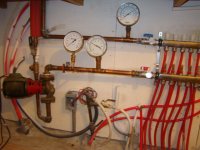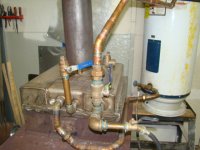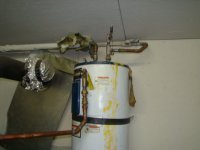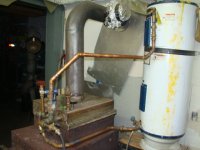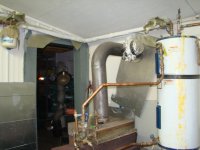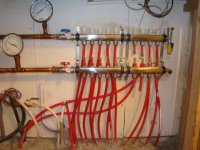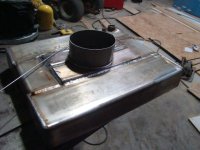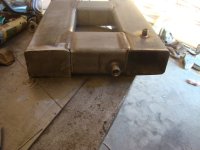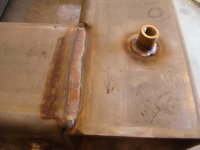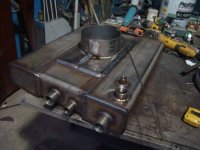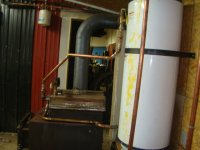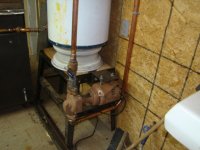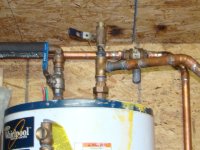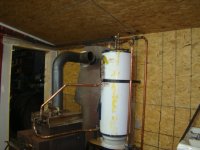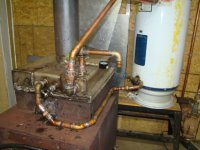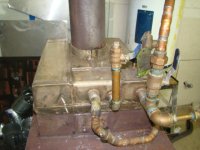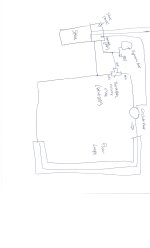mx842
Platinum Member
- Joined
- Feb 26, 2011
- Messages
- 878
- Location
- Richmond Va
- Tractor
- Kubota L3301, PowerKing 2414, John Deere 316, Gravely ZT HD 52
I've been playing around with different ways to heat my shop for several years now and have almost got it to where it is doing ok but would like to do a few things that would make it better.
What I have is a wood stove with a ss tank attached to the top of the stove with the exhaust going out through the center of the tank. The water goes in one end and travels around the sections and out the other end. As the water heats up and leaves the SS tank it rises up a section of 1" copper pipe to a 35 gal water heater. This heated water dumps into the top side port where the pop off valve was and then back to the stove through the old bottom drain port of the hot water heater.
Normally when I start the stove up cold I cut off my circulation pump that I have stationed at my manifold which is connected to this storage tank by roughly 80' of 1" copper pipe. I let the natural rise and fall of the heated and colder water circulate from the stove to the water tank until it heats up the tank to around 120 to 130 degrees. By this time there is hot water already going out of the top hot water port and into the supply line headed to the manifold.
I have a small pressure tank that is plumbed in the supply line about 15' from this hot water outlet port and once I feel hot water leaving the pressure tank I then turn on my pump. Normally when I turn on the pump the water temp leaving the stove has gotten to between 140 and 150 degrees. Once the pump is turned on the water stabilizes in the storage tank to around 120 degrees and stays there as long as I keep the fire going. I keep the fire going all through the day by adding a few pieces of wood every hour or so and at night when I go in I bank it full and cut the draft down low so it don't burn out to quickly. I will normally have a few coals in the bottom in the morning and I can still feel heat on the sides of the stove but the water has cooled down to where I started the day before.
I got through last season like this and even on the coldest days and nights the shop was fairly comfy. I have a couple more tanks I have come across this summer and I want to add one, maybe both to the system for more storage.My question is what would be better.....to run this extra tank in series with the pipping or run it parallel to the tank like it is at the stove? The supply run to the point where I will tie to the pipping to the second tank is about 9 feet off the floor and the bottom of the second tank will be about a foot higher that that.
My thinking is if I 'T' off the hot line to the hot side port on the tank and then 'T' off the cold pipe returning to the stove it would act more as a mixing valve so to speak than a storage tank. I was thinking of trying it this way to see what would happen but thought about asking about it before I ran all that pipe.
The biggest problem I have is that even dumping 110 degree water in the slab the return is always to cold when it gets back to the stove and this causes problems with creosote build up. I have to rod out the stove pipe every couple days to keep the keep it drawing.
As it is now I'm dumping roughly 100 degree water into the manifold, that is connected to roughly 2000 ft of 1/2" pex and by the time it leaves the return manifold it is cold or around 50 degrees. After a couple days of keeping a good fire all day The center sections of the shop floor will warm up 65 degrees in places and cool off as it gets to the outside walls where they stay on average around 50 to 55 degrees.
What I have is a wood stove with a ss tank attached to the top of the stove with the exhaust going out through the center of the tank. The water goes in one end and travels around the sections and out the other end. As the water heats up and leaves the SS tank it rises up a section of 1" copper pipe to a 35 gal water heater. This heated water dumps into the top side port where the pop off valve was and then back to the stove through the old bottom drain port of the hot water heater.
Normally when I start the stove up cold I cut off my circulation pump that I have stationed at my manifold which is connected to this storage tank by roughly 80' of 1" copper pipe. I let the natural rise and fall of the heated and colder water circulate from the stove to the water tank until it heats up the tank to around 120 to 130 degrees. By this time there is hot water already going out of the top hot water port and into the supply line headed to the manifold.
I have a small pressure tank that is plumbed in the supply line about 15' from this hot water outlet port and once I feel hot water leaving the pressure tank I then turn on my pump. Normally when I turn on the pump the water temp leaving the stove has gotten to between 140 and 150 degrees. Once the pump is turned on the water stabilizes in the storage tank to around 120 degrees and stays there as long as I keep the fire going. I keep the fire going all through the day by adding a few pieces of wood every hour or so and at night when I go in I bank it full and cut the draft down low so it don't burn out to quickly. I will normally have a few coals in the bottom in the morning and I can still feel heat on the sides of the stove but the water has cooled down to where I started the day before.
I got through last season like this and even on the coldest days and nights the shop was fairly comfy. I have a couple more tanks I have come across this summer and I want to add one, maybe both to the system for more storage.My question is what would be better.....to run this extra tank in series with the pipping or run it parallel to the tank like it is at the stove? The supply run to the point where I will tie to the pipping to the second tank is about 9 feet off the floor and the bottom of the second tank will be about a foot higher that that.
My thinking is if I 'T' off the hot line to the hot side port on the tank and then 'T' off the cold pipe returning to the stove it would act more as a mixing valve so to speak than a storage tank. I was thinking of trying it this way to see what would happen but thought about asking about it before I ran all that pipe.
The biggest problem I have is that even dumping 110 degree water in the slab the return is always to cold when it gets back to the stove and this causes problems with creosote build up. I have to rod out the stove pipe every couple days to keep the keep it drawing.
As it is now I'm dumping roughly 100 degree water into the manifold, that is connected to roughly 2000 ft of 1/2" pex and by the time it leaves the return manifold it is cold or around 50 degrees. After a couple days of keeping a good fire all day The center sections of the shop floor will warm up 65 degrees in places and cool off as it gets to the outside walls where they stay on average around 50 to 55 degrees.
